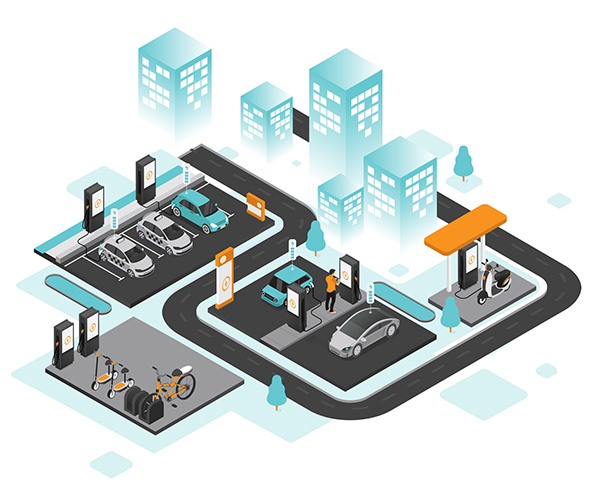AMPLIFY VOL. 37, NO. 3

Europe and other highly developed areas are experiencing a growing interest in transport-oriented development (TOD), which focuses on creating dense, mixed-use zones close to public transportation hubs. TOD encourages a transition from reliance on cars to more sustainable forms of mobility.1 It also aligns with the overarching objectives of sustainable urban development, including improving urban transportation quality, promoting economic growth, and strengthening environmental sustainability.2
This article describes a TOD framework proposal to municipal authorities and urban planners in Dortmund, Germany, to help the city achieve its sustainable development objectives. Dortmund was chosen for several reasons:
-
Most of its infrastructure was built to support coal mining and heavy industry in the 20th century. With coal mining ending, it has experienced dramatic economic and social restructuring.
-
These wide-ranging changes involve infrastructure, economy, and environment.
-
Despite restructuring and change, the city remains vibrant and is capable of reinventing itself.
Dortmund urgently needs innovative urban design that includes sustainable transportation options. Research shows that modern urban development relies heavily on sustainable urban mobility — combining effective, environmentally friendly transportation systems with urban planning to improve quality of life and minimize environmental impacts.3 Sustainable mobility is crucial for tackling issues such as traffic congestion and pollution and optimizing urban-area use.4
TOD emphasizes high-density, mixed-use developments near public transportation to improve urban mobility and land use. It is essential for mitigating urban sprawl and traffic congestion, enhancing the quality of life for city dwellers and promoting environmental sustainability.5,6 TOD has proven effective in reducing traffic congestion in Iranian cities and increasing public transport accessibility and feasibility in South African cities.7,8
The State of Transport & Housing in Dortmund
In Dortmund, private cars are considerably more convenient and flexible than public transportation systems, strengthening people’s dependence on them.9 Although Dortmund’s public transportation system is comprehensive, accessibility is a significant concern, especially in the evening.
Additionally, urban sprawl has made providing public transportation to all parts of the city and surrounding areas difficult. Regular services are often not economically feasible in peripheral regions with low population density.10 Integrating various types of public transportation, such as buses, trams, and trains, is essential to a smooth commuting experience. However, a lack of coordination between the various modes diminishes the appeal of public transit to everyday commuters.11
Dortmund’s public transit faces significant efficiency challenges. Indeed, the city has undergone a years-long remodeling of its train system infrastructure, leading to delays and unreliable service. This discourages locals from using public transportation, leading them to prioritize private car transportation. The extensive use of private vehicles owing to urban sprawl and convenience conflicts with the necessity for sustainable, efficient, and interconnected public transportation networks. A comprehensive strategy is needed to harmonize urban development and transportation planning to establish a more sustainable, accessible, and efficient urban setting.
There are also some housing-related issues. For example, several residential compounds containing multi-apartment options (built in the 1960s and 1970s) lack mixed-use functions and are therefore less than desirable. Some are vacant and currently undergoing a redesign, presenting an opportunity to turn them into more popular living spaces.
The Hannibal, for example, a concrete construction located in Dortmund Dorstfeld-South, has been vacant for years and faces an uncertain future. It could become a TOD pilot showcasing mixed-use living with multifunctional facilities and green spaces. Its durable construction opens the possibility of a refit rather than demolition, in keeping with the city’s sustainability goals.
Proposed Initiatives
Creative ideas and sustainable urban design are needed to transform Dortmund into a model TOD city. The pillars of the proposed initiative include improving public transit systems, building autonomous and pedestrian/bicycle-friendly transit infrastructure, and establishing high-density mixed-use zones with renewable energy solutions.
Enhanced Public Transit Systems
Proposed improvements to Dortmund’s public transit include:
-
Micro-mobility hubs at all major transit points. These hubs provide services such as e-bikes, e-scooters, and compact cars that cater to last-mile connectivity (see Figure 1).
-
Dynamic bus routing. Installing AI-based adjustable bus routing will save travelers time by modifying routes in real time based on current traffic conditions and user demand.
-
Virtual transit networks. An online software application will let users request immediate shuttle ride services. These shuttles close existing gaps in public transit by operating adjustable routes.

Autonomous & Pedestrian/Bicycle-Friendly Infrastructure
Proposed infrastructure plans include:
-
Smart crosswalks. Smart crosswalks include lights and sensors that notify nearby motorists when pedestrians are crossing. They can also modify the timing of lights according to pedestrian traffic to improve safety.
-
Cycling highways. Connecting critical zones of the city with cycling-specified “highways” helps ensure a fast, safe travel experience for those on bicycles.
High-Density, Mixed-Use Developments Near Transit Hubs with Renewable Energy Solutions
Proposed initiatives include:
-
Mixed-use developments. Constructing mixed-use developments that combine commercial, residential, and relaxation spaces within walking distance of transit hubs can dramatically decrease private car use.
-
Community-based energy systems. Visionary approaches to renewable energy solutions include rooftop solar panel systems and kinetic energy tiles that capture energy from people passing through the walking zones for each community in these areas.
Leveraging Collaborative & Technological Strategies
Dortmund’s TOD initiatives require community participation, sustainable technology adoption, and significant infrastructure building. These strategies will ensure the integration of local needs/preferences with cutting-edge solutions for a future-proof urban landscape. They include:
-
Interactive community workshops. City planners should speak with residents, businesses, and local stakeholders to gather input on transit and development proposals.12 Ideally, these workshops will use augmented/virtual reality simulations to help participants visualize the impact of the proposed changes.
-
Online feedback platforms. There is a need to develop online platforms where residents can provide feedback and suggestions on TOD projects.13 This ongoing dialogue ensures that the community’s voice will be heard throughout development.
-
Local advisory panels. It is important to establish advisory panels comprising residents and business owners; these panels can be critical in decision-making, ensuring that TOD initiatives align with community interests.14
The overall impact of TOD from the triple-bottom-line (social, environmental, economic) point of view is shown in Table 1.

Learning from Similar TOD Projects
To help Dortmund achieve its sustainable development objectives, we can draw on several examples from around the world:
-
Transport routes and residential development were prioritized in Kolkata, India, demonstrating how urban planning can improve an area by enhancing transit-point infrastructure.15 Dortmund could likewise stimulate connectivity around its existing public transportation hubs.
-
By using a data-driven TOD approach, China’s Shanghai has experienced noticeable public health improvements and more efficient transportation facilities.16 Dortmund’s TOD initiatives might similarly be refined by using data analytics, helping its initiatives more closely match the city’s needs.
-
In Jakarta, Indonesia, devotion to network management provides a strong, convincing case for the effectiveness of interconnected frameworks.17 Dortmund could benefit from this TOD model, as it leverages private/public collaboration to expedite the implementation process.
-
Palembang, Indonesia, is an excellent example of how a low-carbon city concept can be incorporated into TOD while focusing on the environmental elements of urban development.18 Understanding how the TOD model can help preserve the environment is something Dortmund is eager to include in its urban planning concept.
-
Melbourne, Australia, studied how to “intensify” the city. Australian cities tend to be low-density and car-dependent, and Melbourne is no exception. The study seeks how “transit-related problems and opportunities at different scales interconnect to form synergies and alliances both between projects and scales,” an exploration Dortmund city planners would likely benefit from.19
The case studies from Australia and China, in particular, are in climate zones similar to Dortmund’s, making them interesting from an infrastructure-planning and cultural viewpoint. Although Dortmund is in the very early stages of the TOD process, it is nonetheless progressive because TOD is not widely known in Germany.
Recommendations & Conclusion
Dortmund’s TOD framework includes enhancing the public transportation system, developing autonomous and pedestrian/bicycle-friendly infrastructure, and creating high-density mixed-use urban spaces that utilize renewable energy. Recommendations for policy makers and urban planners include:
-
Strategic placement of transit hubs. Policy makers must carefully organize the strategic arrangements of transit hubs to increase connectivity and enhance progress.
-
Data-driven decision-making. There should be a data-driven strategy in place for the ongoing assessment process and modification of TOD initiatives.
-
Community engagement. It is important to constantly include the community’s viewpoints during the project’s planning stages to ensure the alignment of the developmental process with the preferences of local people.
-
Sustainability integration. TOD project planning should integrate a sustainable environment to encourage eco-friendly activities and green urban areas in the city.
-
Enforce law consideration. It is vital to review building codes and land-use planning to achieve high-rise developments.
In effect, other European cities could use Dortmund’s plan as a blueprint for efficiently combining transport and housing development. Highly populated cities will likely enhance public transport connectivity; lower-density cities may focus on establishing advanced transit hubs with easy-to-use structures. Modifications will be needed to match the specific needs of each city. Still, TOD delivers a flexible approach to urban development — one that is adaptable to the changing needs of urban residents as cities grow.
References
1 Mickiewicz, Pawel, and Katarzyna Radecka. “Urban Transport Quality in Terms of Sustainable Development.” Economic Science for Rural Development Conference Proceedings, Issue 51, 2019.
2 Costa, Carlos Smaniotto. “Reflections on the Role of Urban Mobility in Strengthening Sustainable Green Infrastructures.” Semantic Scholar, 2014.
3 Oleśków-Szłapka, Joanna, Irena Pawłyszyn, and J. Przybylska. “Sustainable Urban Mobility in Poznan and Oslo — Actual State and Development Perspectives.” Sustainability, August 2020.
4 Stojanovski, Todor. “Urban Form and Mobility: Analysis and Information to Catalyse Sustainable Development.” Doctoral thesis, KTH Royal Institute of Technology, 2019.
5 Vega, Julio, Robinson Balcázar, and Xavier Guerra. “Transportation Oriented Development Method: Literature Review.” IOP Conference Series: Earth and Environmental Science, Vol. 1141, 2023.
6 Hardi, April Zumi, and Mohamed Mahmoud H. Maatouk. “The Criteria and Indicators for Applying Transit-Oriented Development (TOD) in Metropolitan Cities Based on Lessons Learned from the International Experiences.” European Journal of Architecture and Urban Planning, Vol. 2, No. 2, May 2023.
7 Mirzahossein, Hamid, et al. “Overview of the Literature on the Transit-Oriented Development to Investigate a Practical Solution for Traffic Congestion in Iran Cities.” International Journal of Transportation Engineering, Vol. 7, No. 4, April 2020.
8 Behrens, Roger, and Sean Cooke. “The Relationship Between Transit-Oriented Development, Accessibility and Public Transport Viability in South African Cities.” Proceedings of the 37th Annual Southern African Transport Conference, Pretoria, South Africa, 9-12 July 2018.
9 Hennig, E.I., et al. “Urban Sprawl in Europe: Joint EEA-FOEN Report.” European Environment Agency (EEA)/Swiss Federal Office for the Environment (FOEN), 2016.
10 Kakar, Khalil Ahmad, and C.S.R.K. Prasad. “Impact of Urban Sprawl on Travel Demand for Public Transport, Private Transport and Walking.” Transportation Research Procedia, Vol. 48, 2020.
11 Weber, Joe, Selima Sultana, and Isabelle Maret. “Urban Sprawl, Commuting, and Access to Public Transportation in the Southeast.” Papers and Proceedings of the Applied Geography Conference, Vol. 29, 2006.
12 Bucolo, Sam, et al. “Transit Oriented Sustainable Urban Developments: Enhancing Community Consultation Through Web-Based Virtual Environments.” Graphite ’03: Proceedings of the 1st International Conference on Computer Graphics and Interactive Techniques in Australasia and South East Asia. Association for Computing Machinery, 2003.
13 Cervero, Robert, and Cathleen Sullivan. “Green TODs: Marrying Transit-Oriented Development and Green Urbanism.” International Journal of Sustainable Development & World Ecology, Vol. 18, No. 3, June 2011.
14 Milan, Blanca Fernandez. “How Participatory Planning Processes for Transit-Oriented Development Contribute to Social Sustainability.” Journal of Environmental Studies and Sciences, Vol. 6, January 2015.
15 Kavta, Kuldeep, et al. “Location Choice Analysis for Transit Oriented Development (TOD): A Case Study of Kolkata.” Lecture Notes in Civil Engineering, Vol. 271, 2023.
16 Qiang, Dan, Lingzhu Zhang, and Xiaotong Huang. “Quantitative Evaluation of TOD Performance Based on Multi-Source Data: A Case Study of Shanghai.” Frontiers in Public Health, Vol. 10, February 2022.
17 Dirgahayani, Puspita, et al. “The Formation of Network Governance in Accelerating the Implementation of TOD: The Case of Jakarta MRT Phase 1, Indonesia.” Case Studies on Transport Policy, Vol. 8, No. 4, December 2020.
18 Asriana, Nova, and Mochamad Koerniawan. “TOD Model Through Low Carbon City Concept in Urban Design (Case Study: Palembang, Indonesia).” IOP Conference Series: Earth and Environmental Science, Vol. 532, 2020.
19 Dovey, Kim, and Ian Woodcock (eds.). “Intensifying Melbourne: Transit-Oriented Urban Design for Resilient Urban Futures.” Melbourne School of Design, The University of Melbourne, 2014.





